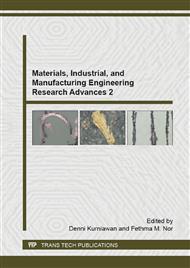p.489
p.494
p.499
p.504
p.511
p.516
p.521
p.526
p.531
Condition Monitoring of a Gear-Box Using Wear Particle Analysis Technique
Abstract:
Wear particle analysis as a nondestructive evaluation technique is an effective method to determine the lubricating oil conditions within different lubricated machines, thus monitoring wear modes and imminent failures in these machines, such as gear-boxes and engines. Ferrographic analysis of wear particles in lubricating oil could give complete information about ferrous and non-ferrous solid debris present in the oil sample. Spectrometric oil analysis could give a direct measure of elemental metal content in the oil such as Iron, Aluminum, Lead and Cupper. These techniques provide cheap, fast and easy methods to use predictive maintenance methods which can replace other conventional methods. The objective of the present study is to apply wear particle analysis technique for condition monitoring of an industrial gear-box transmission over two year’s period of time. This gear-box belongs to one of the machines of the Oriental Weavers Company (OWC), one of the largest carpet manufacturers in the world. Spectrometric and ferrographic analysis were used where quantitative and qualitative changes in the concentration and size distribution of different particles were analyzed and compared to baseline values.
Info:
Periodical:
Pages:
511-515
Citation:
Online since:
October 2015
Authors:
Price:
Сopyright:
© 2015 Trans Tech Publications Ltd. All Rights Reserved
Share:
Citation:


